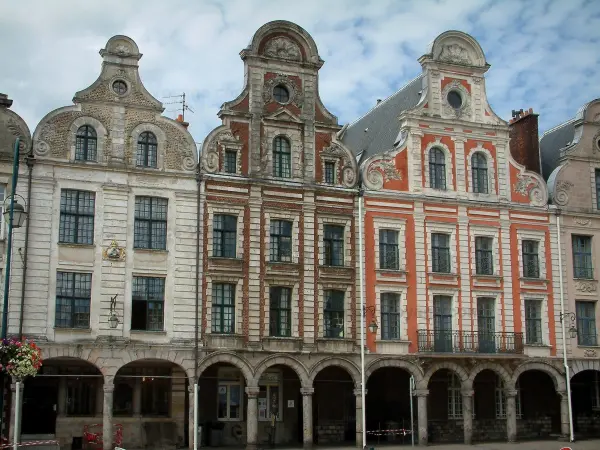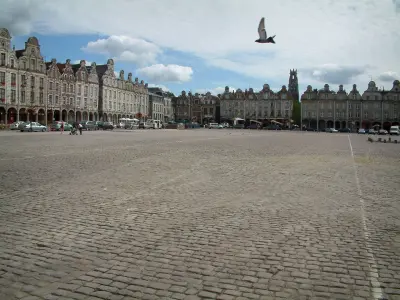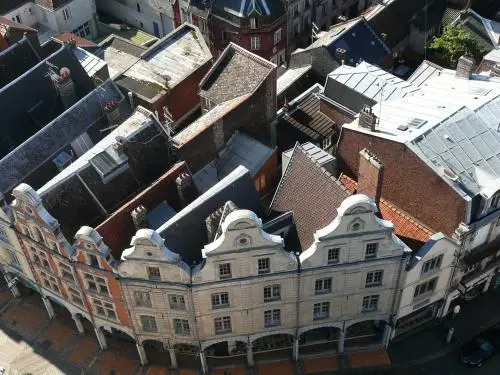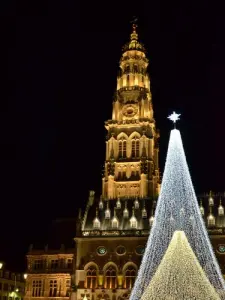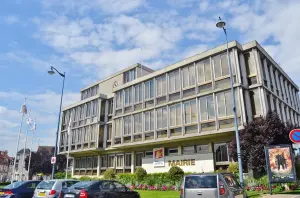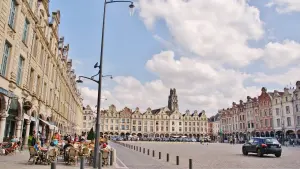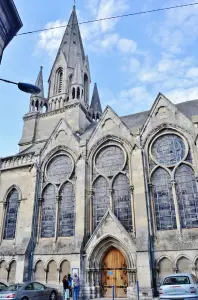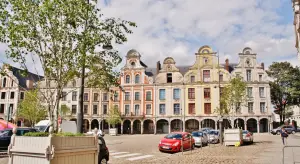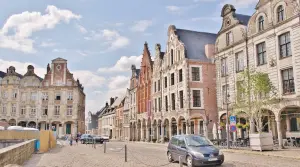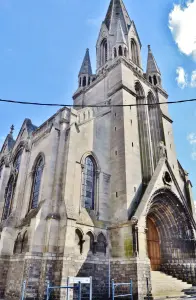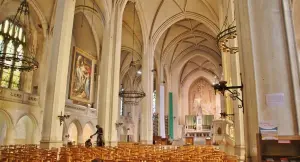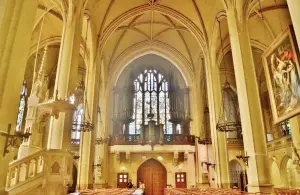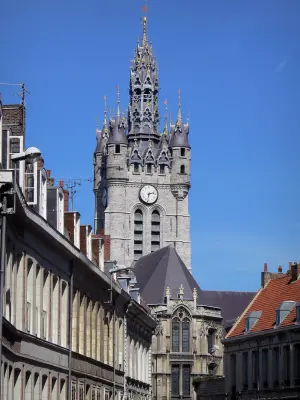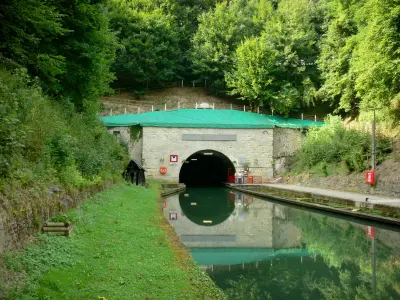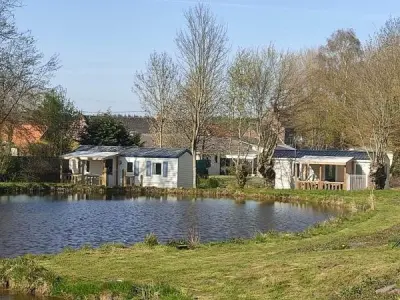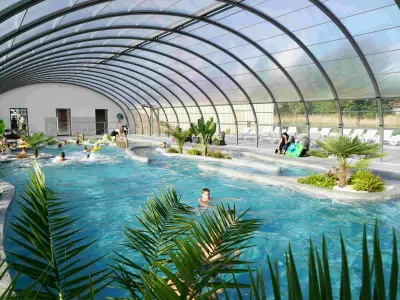The third biggest city in Pas-de-Calais, Arras is famous for its two magnificent cobbled squares: Grand'Place and Place des Héros (Heroes Square). Surrounded by 155 Flemish Baroque-style houses, they are the pride of Arras residents and are greatly admired by visitors. Lined with covered galleries housing fine food shops and cafés, Place des Héros is dominated by the city hall's impressive belfry, a UNESCO listed site. From a height of 75 metres, the view it offers of the city and surrounding countryside is superb!
Another building worthy of your attention is the old Benedictine Abbey of St. Vedast, whose origins date back to the 7th century. In the 18th century, reconstruction and renovation work was undertaken, resulting in this extremely elegant style, like in the main courtyard. The former abbey church has been converted into a cathedral, whereas the abbey houses the Museum of Fine Arts, devoted to painting and sculpture.
You can also discover Arras from its depths. Located 12 metres underground, the boves are former chalk quarries dug in the 10th century to form a very extensive network of tunnels. They provided shelter for Allied soldiers in the First World War before they valiantly went to fight in the Battle of Arras in April 1917. Yet the boves are not the only reminder of that victorious battle. A system of tunnels dug by New Zealand miners, the Carrière Wellington was a hiding place for 24,000 English soldiers, making the place a first-rate remembrance site.
Continue your tour of the city via the citadel. Built by Vauban in the 17th century, today it is a UNESCO World Heritage Site. If you have brought the family, the Cité Nature is a great attraction for children with its exhibitions about the environment, food and agricultural history. They can take part in workshops and activities, too.
Before you leave Arras, above all remember to sample one of its delicious specialities: Arras hearts (cœurs d'Arras), little heart-shaped gingerbread biscuits. And if you are visiting in March, the carnival is an unmissable event.
A city with the highest density of monuments in France, Arras takes place in the Hauts-de-France, in the Pas-de-Calais. Third most populated commune of the department, behind Calais and Boulogne-sur-Mer, it is about fifteen kilometers from Lens, and about forty kilometers from Lille.
A privileged residence of the Counts of Flanders in the ninth century, Arras underwent an important development between the twelfth and thirteenth centuries. The city is then known for its drapery activity which extends throughout much of Europe at the time. Burgundy between the fourteenth and fifteenth century, the city of Arras joined the bosom of France in the seventeenth century under Louis XIII. The cloth industry is gradually collapsing, giving way to a craft-oriented activity. Destroyed during the two world wars, the city reborn from its ashes only in the 1990s.
Today, Arras is a popular tourist city due to its very rich architectural heritage. Classified as a City of Art and History, it is also part of the Network of Major Sites of Vauban and has been awarded four flowers in the competition of cities and floral villages of France.
The citadel of Arras has a classification to the Historical Monuments and the world heritage of UNESCO, as its belfry. This fortress of the second half of the 17th century was demilitarized in the years 2010 and is now used as a venue for shows or leisure events like the Main Square festival.
Gothic style, the belfry date from 1463. Completed in the middle of the 16th century, it takes place next to the Arras town hall of flamboyant Gothic style. Destroyed by shelling in October 1914, they were both rebuilt identically.
At the beginning of the 16th century, the town hall was classified as a Historic Monument. In addition to its main building, it features a Renaissance-style annex, and was inaugurated by the Emperor Napoleon III.
But it is principally known for its two main squares, the Grand Place and the Place des Heroes, that the town of Arras is principally known. Surrounded by 155 Flemish Baroque-style houses listed or classified as Historic Monuments, they offer an authentic pavement. The second one also unveils covered galleries with original shops and attractive cafes.
Classified as Historical Monuments, the Notre-Dame-et-Saint-Vaast Cathedral was built at the end of the 18th century in a classical style. It is the work of Pierre Contant d'Ivry, architect of the Madeleine church in Paris.
A former Benedictine abbey, Saint-Vaast abbey was founded in the 7th century on the hill of La Madeleine, the usual place of refuge for Saint Vaast. In the seventeenth century, the establishment was the origin of the creation of one of the three first colleges of the university of Arras, and thus becomes an important center of culture. Since 1825, the building hosts the Fine Arts Museum of Arras, featuring works by Brueghel le Jeune, Charles Le Brun, Camille Corot, Théodore Rousseau and Eugène Delacroix. Collections of art objects are also present, including sculptures.
Several religious buildings take place in Arras, like the chapel of the Chariottes of the eighteenth century, classified as Historical Monuments, the convent of the Clares founded in the 15th century and listed in Historical Monuments, or the Abbey of Henin-Lietard, A former religious center created by the Order of St. Augustine in the seventh century. One can also admire some vestiges of the abbey of Mount Saint-Eloi, former refuge of the monks in the XIth century inscribed with the Historic Monuments.
The Fontaine du Pont-de-Cité, also known as the Neptune Fountain, was built in the 1860s by the architect François Constant Bourgeois. It takes place at the site of the ancient ramparts and represents the god of the Sea.
Originally the episcopal palace, the hotel of the prefecture of the Pas-de-Calais has been listed in the Historic Monuments. Built in the second half of the 18th century, it was remodeled identically in the middle of the 19th century following a devastating fire.
A leisure center takes place at the northern entrance of Arras, including the Cité Nature, a museum entirely devoted to science and housed in a former industrial wasteland redesigned by Jean Nouvel. Right next door, a balneoludique center, the Aquarena, takes place in a futuristic building topped by a large black pearl. You can enjoy swimming pools, slides, hammams, saunas or a fitness center.
Wellington's career traces the history of the battle of Arras at the end of the First World War in 1917. There is a network of undergrounds that played a major role in this murderous conflict.
Do not miss the Hotel de Guignes, an 18th century mansion which has now been converted into a venue for concerts and other cultural events.
Five markets take place at Arras on Wednesdays, Thursdays, Saturdays and Sundays morning, as well as on Thursday afternoons. A big sale is held on the last Sunday of June.
Between January and March, the university hosts a festival of current musics, MusiKampus.
In March, the University of Artois offers an international and academic festival of the performing arts.
The book fair of popular expression and social critic is held every year on May 1st.
Each year in early July, the citadel of Arras hosts the Main Square Festival, one of the most important rock music festivals in France.
Between July and August, Arras on the Beach turns the Grand'Place into a giant beach with entertainment.
The International Film Festival of Arras is held in November.
A Christmas market is organized in December.
